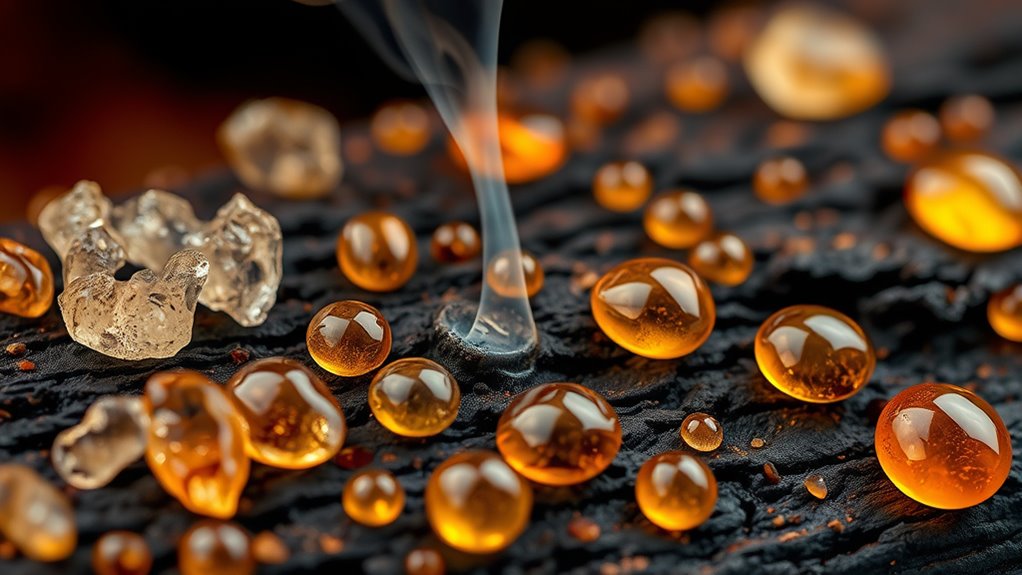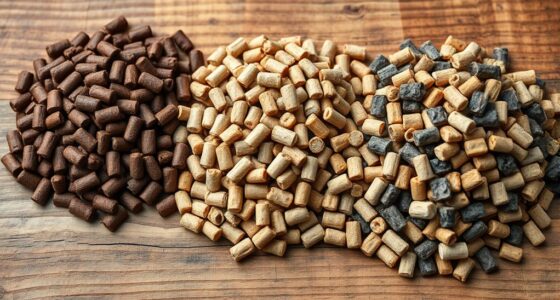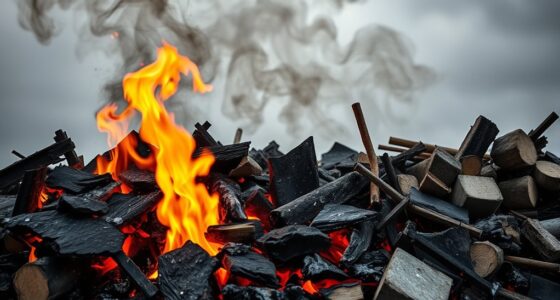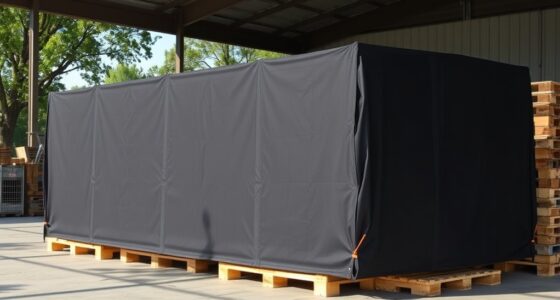Resin and sap contain volatile compounds that make materials ignite more easily and burn more intensely. Resin’s chemical makeup allows it to vaporize quickly, fueling flames, while sap acts as a natural accelerant, lowering ignition temperatures. Their presence can cause fires to spread faster and burn hotter. If you want to understand the specific ways these substances influence fire behavior and safety measures better, there’s more to discover about their combustion properties.
Key Takeaways
- Resin’s volatile compounds vaporize easily, making it ignite quickly and intensify fires.
- Sap acts as a natural accelerant, lowering ignition temperatures and promoting rapid combustion.
- Both substances increase flammability, leading to faster fire spread and higher flame intensity.
- Their chemical makeup can influence combustion behavior, affecting fire safety and control measures.
- Treatments can enhance flame retardancy of resin- and sap-containing materials to reduce fire risks.

Have you ever wondered how resin and sap affect combustion? These natural substances play a vital role in how materials ignite and burn, influencing both ignition properties and flame retardancy. When you’re dealing with wood, plants, or other organic materials, understanding the behavior of resin and sap becomes essential, especially if you’re involved in fire safety, woodworking, or even crafting. Resin and sap contain complex chemical compounds that directly impact the ease with which materials catch fire and how they behave once ignited.
Resin, in particular, is known for its flammable nature. It often contains volatile organic compounds that can vaporize easily at relatively low temperatures. This makes resin-rich materials more susceptible to ignition because their ignition properties are heightened—they ignite quickly and with less heat. If you’re working with resin-infused wood or plant matter, you might notice that they spark up faster than other materials. This rapid ignition can be a hazard, especially in scenarios where fire control is critical. On the flip side, the presence of resin can sometimes improve flame retardancy if it’s treated or combined with other flame-retardant substances, but generally, untreated resin tends to accelerate combustion.
Sap, on the other hand, contains sugars, oils, and organic acids that influence how a material burns. Sap can act as a natural accelerant, lowering the ignition temperature and making fire spread more rapidly. When sap is present in large quantities, it can cause a material to ignite more easily and burn more intensely. This is why dried sap or resinous material can be particularly hazardous in fire-prone environments. Additionally, the chemical composition of sap can be modified or treated to improve flame retardancy, which is an important consideration in fire safety applications. For example, certain fire-retardant coatings or additives can be applied to sap-rich materials to slow down combustion or prevent ignition altogether.
The chemical makeup of resin and sap also affects how a fire develops once started. Their combustibility influences the flame’s intensity and duration, affecting both safety measures and fire response strategies. If you’re designing fire-resistant materials or trying to assess fire risk, understanding these ignition properties and their contribution to flame retardancy is essential. Additionally, the presence of resin and sap can influence the flammability and combustion characteristics of organic materials. For instance, some resins and saps contain volatile compounds that can intensify fires once ignited. Moreover, the combustion rate of resin and sap-rich materials can vary significantly depending on environmental conditions such as humidity and temperature. Overall, resin and sap profoundly influence combustion behavior, and knowing how they behave can help you make smarter decisions whether you’re aiming to prevent fires or control their spread.
Frequently Asked Questions
How Does Resin’s Chemical Composition Influence Its Combustion Properties?
Resin’s chemical composition impacts its combustion properties by influencing its chemical stability and combustion efficiency. When resin contains volatile compounds, it ignites easily and burns quickly, reducing efficiency. Conversely, more chemically stable resins resist premature ignition, leading to more controlled combustion. Understanding these chemical traits helps predict how resin will perform as a fuel, allowing you to optimize burning conditions for better efficiency and safety.
Can Sap Levels Predict the Flammability of Plant Materials?
Like a flickering candle revealing hidden truths, sap levels can indeed predict the flammability of plant materials. Higher sap flammability indicates increased resin content, serving as resin predictors for easier ignition. When you examine a plant’s sap, you’re fundamentally reading nature’s own fire risk report. Elevated sap levels suggest greater risk, helping you assess how readily the plant material might ignite and burn, much like reading a map to fire safety.
What Are the Environmental Impacts of Resin and Sap Burning?
Burning resin and sap releases air pollution and toxic emissions, which can harm your health and the environment. You might notice increased smog or respiratory issues after burning these substances. They emit harmful chemicals like volatile organic compounds (VOCs) and particulates, contributing to air quality deterioration. To protect ecosystems and your community, avoid burning resin and sap, and opt for cleaner energy sources whenever possible.
How Do Temperature and Humidity Affect Resin and Sap Combustion?
You might think higher temperature always promotes resin volatility and sap ignition, but humidity plays a vital role. Increased humidity can suppress resin volatility, making ignition harder, while dry conditions boost combustion. When it’s hot and dry, resin and sap ignite more easily, leading to rapid combustion. Conversely, high humidity dampens resin volatility, slowing or preventing ignition. So, both temperature and humidity directly influence how efficiently resin and sap combust.
Are There Safety Measures Specific to Burning Resin and Sap?
When burning resin and sap, you should use fire suppression techniques like having a fire extinguisher nearby. Always wear protective gear, including gloves and goggles, to prevent burns and inhalation of fumes. guarantee proper ventilation and keep a safe distance. Follow safety guidelines to minimize risks, and be prepared for emergencies. These measures help keep you safe while managing the flammability of resin and sap during combustion.
Conclusion
Remember, when it comes to resin and sap, they can turn a simple fire into a blazing one. Their flammability can ignite quickly, fueling the flames and making combustion more intense. Always be cautious around these substances, because as the saying goes, “A little spark can start a big fire.” Stay aware of how resin and sap influence burning, and you’ll keep yourself safe while respecting the power of fire.











